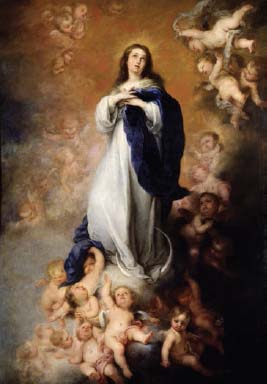Baroque and Beyond C. 1600–1850The Golden Age of Spain |
What is Murillo’s Immaculate Conception? |
Bartolome Esteban Murillo (1617–1682) was an important Spanish painter based in Seville whose art emphasized images of the Virgin Mary and the saints, and was painted according to rules set out by the leaders of the Catholic Counter-Reformation, which specified the manner in which the Virgin Mary could be depicted. Murillo painted multiple different paintings of the Immaculate Conception including The Immaculate Conception of theEscorial (c. 1678), which conforms to these rules. The Immaculate Conception is a Catholic Doctrine, not fully accepted as dogma until the nineteenth century, stating that the Virgin Mary was born without Original Sin. In Murillo’s painting, Mary is clothed in blue and white and she appears suspended in a glowing, heavenly space surrounded by cherubic angels. Her face looks upward, her hands are held in prayer, and her feet gingerly rest upon a delicate crescent moon, an image derived from Revelation 12:1, “And there appeared a great wonder in Heaven: a woman clothed with the sun and the moon under her feet” (as quoted in Janson 696). The delicate sweetness of Murillo’s paintings influenced Spanish painters in the New World for nearly two hundred years.

Murillo’s light-filled paintings of the Immaculate Conception inspired Catholic artists for hundreds of years in both Spain and Latin America.
